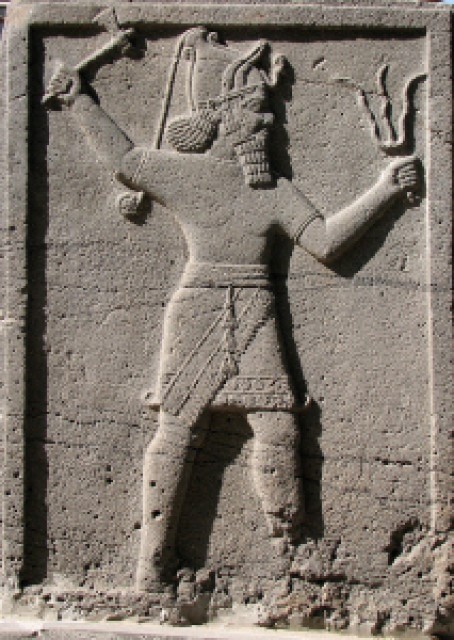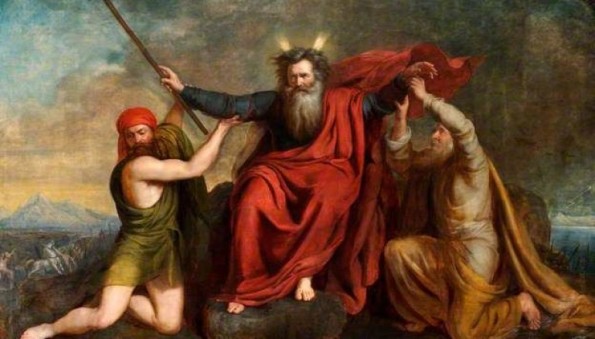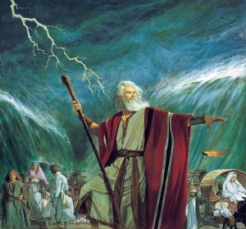Who is in charge? Who owns this staff?
Is this Moses’ staff or Aaron’s staff or God’s staff? (Exodus 4:2, 7:15, 17:20, 9:23, 10:13 versus Exodus 7:9-12, 7:19 versus Exodus 4:20)
Exodus 4:2, 7:15, 7:20, 9:23, and 10:13 all indicate that the staff or rod involved in producing Jehovah’s signs was Moses’ staff, perhaps even his personal shepherd’s staff. Exodus 7:15 refers to the rod that was previously used to turn into a serpent, which in chapter 4 of Exodus (the story it is referring to) makes this Moses’ staff. Indeed Exodus 4:2, which introduces the staff in the storyline, seems to imply that it was already on Moses’ person: “‘What’s this in your hand?’ ‘A staff.’”
This is where we get into complications. Exodus 7:10, 7:12, and 7:19 refer to the same staff now as “Aaron’s staff” and, more surprisingly, seem to reflect that it was Aaron, not Moses, who performed the famous rod-to-snake miracle we read about in Exodus 7:10. When we get into the account in Exodus 7:20 of the first plague (water into blood) it gets really confusing as it doesn’t categorically say who owns the staff when it says, “And Moses and Aaron did so, as the LORD had commanded, and he lifted up the rod, and smote the waters…” To me the “he” in verse 20 could be Moses or Aaron, but it would seem logical to assume that this is Aaron’s rod as verse 19 the command from God is to Aaron to use his rod. Students over the years have asked me, “So who is doing the miracle? Is it Aaron? Is it Moses? Could it be both? Why is this so confusing?”
In my early years of teaching I would just say that I don’t know. The more I have studied, I now know that I really don’t know! Over the years I have been exposed to scholarship that has been helpful to see how the Bible came to be. Joseph Smith was spot on when he said, “I believe the Bible as it read when it came from the pen of the original writers. Ignorant translators, careless transcribers, or designing and corrupt priests have committed many errors.”[1]Teachings of the Prophet Joseph Smith, Joseph Fielding Smith (1976), 327.
Lately when I am asked about the confusing nature of this biblical account, I have said, “Welcome to the world of the Bible!”
As if things don’t get complicated enough, Exodus 4:20 says that it really isn’t Moses’ or Aaron’s rod anyway, it is God’s, “And Moses took his wife and his sons, and set them upon an ass, and he returned to the land of Egypt; and Moses took the rod of God in his hand.”
What is with this rod anyway?
We read about the “rod of iron” in both the book of Revelation and the Book of Mormon (see 1 Nephi 8-11 and Revelation 2) But what about this rod? I think in part that this rod symbolized Moses’ right to rule. He was the prophet leader of this people that God had chosen to come out of slavery and bring unto him, to freedom, to his land, and his covenant.
The iron rod in the Book of Mormon makes sense as a divine weapon, an extension of the king, in this case the king is God. As Zachary Nelson shared,
Rods were also important symbols of authority or rule. Legend has it that Adam’s rod was cut from the tree of life, making it appropriate that the rod of iron directs Lehi’s descendants back to the rod’s ultimate origin, the tree of life. Hugh Nibley noted: “The rods of Adam, Enoch, Elijah, Moses, Aaron, David, Judah, etc., were actually thought of as one and the same scepter, loaned by God to his earthly representative from time to time as a badge of authority, and an instrument of miracles, proving to the world that its holder was God’s messenger. But such a thing is also the law, and the Rabbis spoke of the law as God’s staff, to lead and discipline his people.” Further, Nibley explained, “For the ancients it was quite possible for a piece of wood to be at one and the same time a scepter, a rod of identification (which was only a private scepter), and a book (which was a message written on or attached to the sender’s staff).”[2]Zachary Nelson, “The Rod of Iron in Lehi’s Dream,” in Religious Educator10, no. 3 (2009): 49–58.
It is not unusual in ancient near eastern writings to find gods depicted with magical or divine weaponry.[3]Alberto Ravinell Whitney Green, The Storm god in the Ancient Near East, p. 181. Stelae preserved from the ancient Levant commonly portray Mesopotamian deities with maces, swords, thunder bolts, and clubs in their possession. Brett Holbrook said:

The gods often possessed magical weapons of cutting power, like the blade the Hittite gods had with which they cut heaven and earth asunder. Thirteenth-century B.C. rock carvings from Yazilikaya in Anatolia depicted Hittite warrior-gods bearing swords. In the Ugaritic myths, Baal wielded a blade in his right hand before the divine council and the war goddess Anat killed Mot with a sword. From the Akkadian myths, the hero-king Gilgamesh had a sword with which he killed the wilderness monster Huwawa and the Bull of Heaven… Yahweh, the God of Israel, has been referred to as using a sword. Many of his servants who visited mortals in his name also wielded a sword: the “captain of the host of the Lord” to Joshua and the “angel of the Lord” to Balaam and David (Joshua 5:13—15; Numbers 22:23, 31; 1 Chronicles 21:16). Such divine beings equipped with swords also appeared in Canaanite and Akkadian texts and iconography.[4]Brett Holbrook, The Sword of Laban as a Symbol of Divine Approval and Kingship, Journal of Book of Mormon Studies: Volume – 2, Issue – 1, Pages: 39-72.
Additionally, many of the Assyrian kings claimed to possess weapons belonging to the gods, specifically staffs—an idea which even finds parallels in ancient Greek culture where it is claimed that Agamemnon wields the staff of Zeus as in the Iliad. Thus, there is biblical precedent for divine weaponry or other paraphernalia imagery in both Canaanite religion and ancient Near Eastern stories of their gods and kings. These ideas and imagery were adopted and adapted by the biblical scribes who wrote down these oral traditions that contributed to our bibles that we have today.
It makes sense when we read in the Bible that Jehovah was a god who owned a staff or sword (Isaiah 10:24-26, 30:30-32; Ezekiel 20:37, 30:24-25), and he is even referred to as a staff-wielding shepherd (Micah 7:14). There are also references in the text of the Bible to angels bearing staffs, such as Gideon’s angel (Judges 6:21).
Back to the real owner of the staff/rod
So who is the rightful owner of this staff that is used to perform these miracles? We have an obvious definite textual variation that must be dealt with here! In my opinion, the difference in these two accounts can be explained if we see that there are two textual sources at work in these stories. Scholars call these two textual sources E and P, E meaning the Elohist text and P meaning the Priestly text. Richard Friedman, in his work The Bible with Sources Revealed shows how the textual variants were put together in Exodus 7. The idea is that the Priestly author altered an earlier text where Moses was portrayed as the original owner of the staff/rod, imposing his own agenda into this story. This new version of events paints Aaron in a light equal to if not superior to Moses, also making a case for the legitimate rule of the House of Aaron as the rightful heirs of the priesthood in the 7th century BCE.
Indeed, as Richard Friedman says, P is all about making the case that the House of Aaron, or the Aaronids were to be above the Levites in every way. He says,
P makes the distinctions between Aaronid priests and all other Levites. This distinction is of tremendous importance in P. It comes up repeatedly in the P narrative and law codes. Only the Aaronids may serve as priests; all other Levites serve as lesser clergy. The book of Chronicles reports that this distinction was a development of the reign of Hezekiah (2 Chronicles 31:2). Moreover, this distinction appears in a source of the book of Chronicles that was composed during the reign of Hezekiah, which argues especially for its accuracy. From the time of Wellhausen, this innovation was widely held in scholarship to derive from the prophet Ezekiel (especially Ezekiel 44), but this was not correct. Ezekiel does not distinguish Aaronid priests from the other Levites. He specifically distinguishes one particular group of priests, the Zadokites, not Aaronids. Moreover, since it has now been shown linguistically that the Hebrew of P precedes that of the book of Ezekiel, it is no longer possible to argue that this central innovation of P is based on that prophetic book. The separation of Aaronid priests from the Levites is a Hezekian event.
This is complemented by the other major mark of P: centralization of worship. In J and E, people sacrifice at various locations. But in P, one is permitted to sacrifice only at the Tabernacle and nowhere else on earth. This, too, was a Hezekian policy, eliminating all places of sacrificial worship outside the Temple in Jerusalem. Kings and Chronicles coalesce on this point: there was no centralization before Hezekiah… In P it says more than a dozen times: the performance of these commandments at the Tabernacle is the law forever (Exodus 27:21; 28:43; 30:21; Leviticus 3:17; 6:11; 10:9; 16:29,34; 17:7; 24:3,8; Numbers 18:23; 19:10). This view in P of the necessity of the Tabernacle’s presence forever further supports the linguistic and historical connections of P to the era in which the first Temple was standing in Jerusalem.[5]Richard Friedman, The Bible with Sources Revealed, p. 22-23.

Putting Aaron in a superior position and changing the story to make Moses’ staff to Aaron’s staff reflects a centuries long rivalry over the legitimacy claims of the priesthood between the Levites and the House of Aaron. This is how scribes of the Bible and the ancient world denigrated the position and claims of their rival, by disparaging their forefather.
In both the Golden Calf narrative (Exodus 32), an E text, and Numbers 12 (also E), Aaron is portrayed negatively and Moses and the Levites save the day. When the P author writes stories about Moses, we see the opposite – Moses has “uncircumcised lips” (Exodus 6:12, 20), doesn’t own his own staff (Exodus 7;10, 12, 19) and the Levites are downgraded to inferior roles to the House of Aaron (Numbers 3:5-10, 16:8-11, 16:17, 18:1-7). P makes Moses the younger brother of Aaron, when in fact the E text of Exodus 4:14 says, “And Jehovah’s anger flared at Moses, and He said, ‘Isn’t Aaron your Levite brother?’” This does not mean that Moses and Aaron were brothers. On the contrary, if they were siblings it would naturally say “your brother.” Why would it say “your Levite brother”? If they are actual brothers, they must both be Levites! “Your Levite brother” has to mean “fellow Levite,” and so we read in E that Moses and Aaron are not siblings. Exodus 15:20, another E text, shows that Miriam is listed as a sister to Aaron, but not to Moses. Only in P is Aaron the brother (and the older one at that) of Moses. Also in Exodus 7:1 it says that “Aaron, your brother, will be your prophet.” To me this is a definite attempt to make Aaron the superior of Moses! There are layers to these stories! The scribes that left us these accounts are vying for supremacy as they rewrite ancient oral traditions and stories to paint themselves as superior to each other!
What are we to make of this? How does it relate to the JST (The Joseph Smith Translation)? How can we apply this knowledge in our lives? Does this even matter? I will be addressing these questions soon in other posts.
References
| ↑1 | Teachings of the Prophet Joseph Smith, Joseph Fielding Smith (1976), 327. |
|---|---|
| ↑2 | Zachary Nelson, “The Rod of Iron in Lehi’s Dream,” in Religious Educator10, no. 3 (2009): 49–58. |
| ↑3 | Alberto Ravinell Whitney Green, The Storm god in the Ancient Near East, p. 181. |
| ↑4 | Brett Holbrook, The Sword of Laban as a Symbol of Divine Approval and Kingship, Journal of Book of Mormon Studies: Volume – 2, Issue – 1, Pages: 39-72. |
| ↑5 | Richard Friedman, The Bible with Sources Revealed, p. 22-23. |



No Comments
Comments are closed.